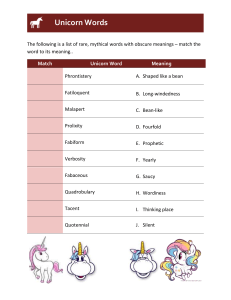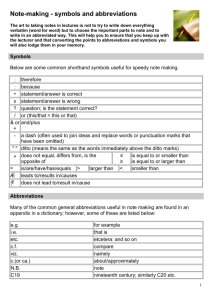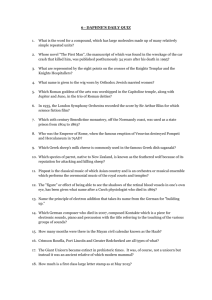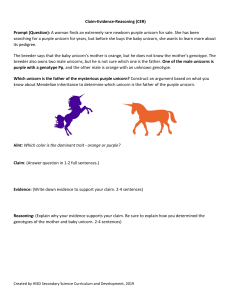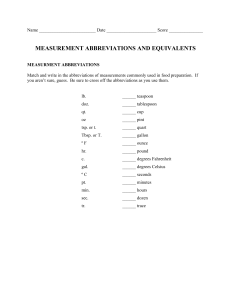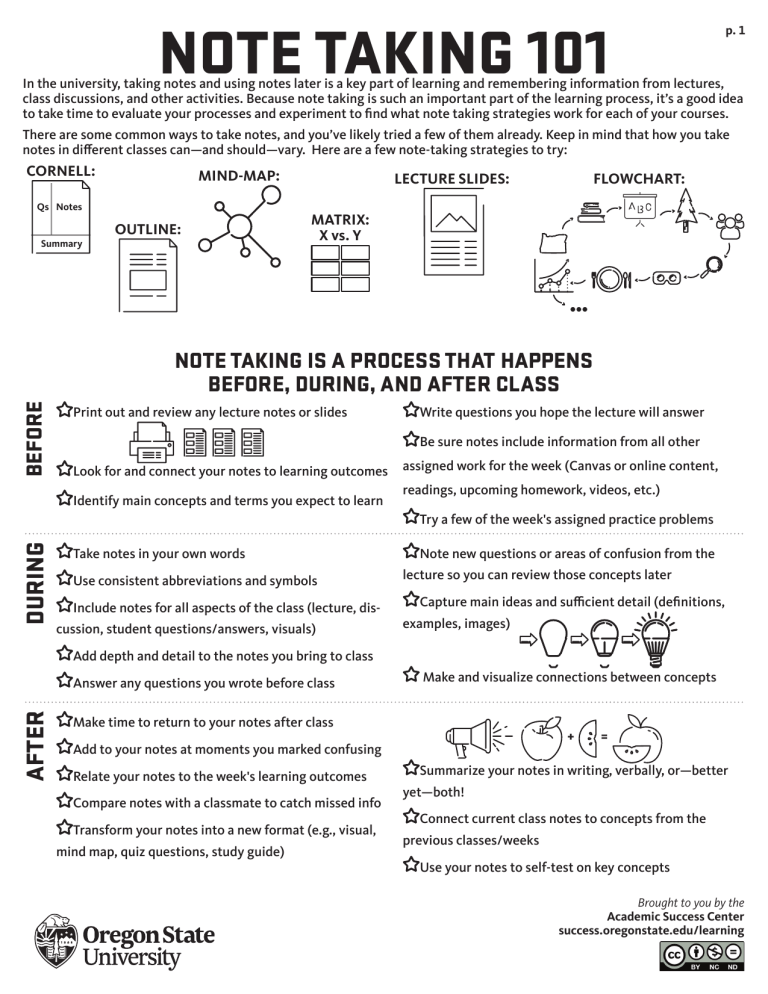
NOTE TAKING 101 p. 1 In the university, taking notes and using notes later is a key part of learning and remembering information from lectures, class discussions, and other activities. Because note taking is such an important part of the learning process, it’s a good idea to take time to evaluate your processes and experiment to find what note taking strategies work for each of your courses. There are some common ways to take notes, and you’ve likely tried a few of them already. Keep in mind that how you take notes in different classes can—and should—vary. Here are a few note-taking strategies to try: CORNELL: MIND-MAP: Qs Notes Summary OUTLINE: LECTURE SLIDES: FLOWCHART: MATRIX: X vs. Y ••• BEFORE NOTE TAKING IS A PROCESS THAT HAPPENS BEFORE, DURING, AND AFTER CLASS Print out and review any lecture notes or slides Write questions you hope the lecture will answer Be sure notes include information from all other Look for and connect your notes to learning outcomes Identify main concepts and terms you expect to learn assigned work for the week (Canvas or online content, readings, upcoming homework, videos, etc.) DURING Try a few of the week's assigned practice problems Take notes in your own words Use consistent abbreviations and symbols Include notes for all aspects of the class (lecture, discussion, student questions/answers, visuals) Note new questions or areas of confusion from the lecture so you can review those concepts later Capture main ideas and sufficient detail (definitions, examples, images) Add depth and detail to the notes you bring to class AFTER Answer any questions you wrote before class Make and visualize connections between concepts Make time to return to your notes after class + Add to your notes at moments you marked confusing Relate your notes to the week's learning outcomes Compare notes with a classmate to catch missed info Transform your notes into a new format (e.g., visual, mind map, quiz questions, study guide) = Summarize your notes in writing, verbally, or—better yet—both! Connect current class notes to concepts from the previous classes/weeks Use your notes to self-test on key concepts Brought to you by the Academic Success Center success.oregonstate.edu/learning NOTES ARE ONLY AS GOOD AS WHAT YOU DO WITH THEM LATER! p. 2 Notes are a starting point for exam prep. Your notes will be most useful if you think of them as a jumping off point for further learning. Put your notes to good use! Your brain will remember information better if it’s seen it multiple times and has different pathways for accessing the information. Use all of your senses. Whenever possible, using a range of senses while taking and using notes can help you remember information. For example, try writing your notes, then talking through them with a classmate, then drawing a picture based on main concepts. Make connections. Don’t let lecture be the first (or last!) time you hear about a concept. Read and take notes before class, add to notes during class, and make connections between concepts during and after class. 10 GREAT WAYS TO USE YOUR NOTES: Here are a few ways you can use your notes to create longterm memories and recall information on a test or in the next class you take which builds on the information. 1. Visit office hours to talk through questions you noted during lecture. ? ! 2. Make a study guide. The best times to see the unicorn are in the early morning and at dusk, right before nightfall. Narwhal tusks have been sold before as unicorn horns, much as the skate fish has been sold as scallop and monkfish as lobster. Unicorns, however, do not dwell in the sea, though they may be found in fields near the sea. 4. Transform your notes into a visual. 8. Make visual connections between notes from different lectures. + = 5. Fill in answers to questions you write during class. ? 2. Which of the following is true: a. Unicorns can only be seen in the mist. b. Narwhals are mythical creatures. c. An even more mythical beast than both the narwhal and the unicorn is the uniwhal, which sports the head of a unicorn and a narwhal’s body. d. All of the above. 9. Identify real-world examples of main concepts. & Why is the unicorn truly incredible? Because magic. 1. Describe 3 characteristics specific to the unicorn, shared by the narwhal. 7. Make and organize post-it notes. 3. Write a summary of main points. & 6. Write practice test questions. ! = 10. Explain the main points from class to a friend who wasn’t there. I get it! 4 WAYS TO POWER UP YOUR NOTE TAKING STRATEGIES! • Your working memory stresses less when #1 TAKE NOTES you think in your own words. IN YOUR OWN WORDS #2 TRANSFORM YOUR NOTES AFTER CLASS • • Transforming notes into a summary, diagram, or mind map creates new retrieval paths to your memory • The test won’t look like your notes; using and applying notes gives you practice with the material in different formats #3 TAKE NOTES NO MATTER WHAT #4 TAKE NOTES BY HAND IF POSSIBLE When you transcribe lectures, you spend less time learning concepts during lecture • Instructor notes and slides are a good starting point, but your thinking matters! • Include associations, questions, and details that might not be captured in the slides • Note-taking on your laptop can invite multitasking and distract from listening and learning • You can always convert your notes to a digital format later as part of your study process NOTE TAKING MYTH BUSTERS p. 3 MYTH: All you need to do is take notes during class FOR REALS: Notes are only as good as what you do with them after class. Learning happens when you put notes to use. Here are a few ways to commit notes to memory: • Transform your notes into a new format (summary, visual, diagram, etc.) • Explain your notes and main points aloud to someone else • Write possible test questions based on your notes • Create a study guide that you add to each week with new information and connections you’ve made MYTH: You should write down everything you hear in lecture FOR REALS: Don’t do that. You might end up tuning out content if you only focus on transcription. Or you might get super stressed if you miss a word. Instead… • Listen for key points • Translate ideas into your own words • Listen 80% of the time and write 20% of the time • If you know you have a question about a concept, don’t stress. Mark it, so you can review it later with other materials or in office hours MYTH: There is one “right” way to take notes FOR REALS: You should find a system that works for you. The important elements to remember in any system are • • • • Take notes in your own words Be brief. Use phrases and abbreviations Include enough detail to use (and transform) the notes later Leave space to add information from other sources MYTH: Quantity = Quality FOR REALS: Excessive note taking may not be quality note taking. Check your balance between listening, learning, and note taking by asking… • Am I focused on comprehension during lecture (rather than on transcription)? • Can I recall and explain what I learned after lecture? • Do my notes have enough main points and detail for me to use them later in a new way? (e.g. writing a summary, drawing a mind map) 3 MORE WAYS TO POWER UP YOUR NOTE TAKING STRATEGIES! #5 USE CONSISTENT ABBREVIATIONS & SYMBOLS #6 BE OPEN TO TRYING NEW THINGS #7 TAKE NOTES IN ALL OF YOUR LEARNING ENVIRONMENTS • Using abbreviations and symbols for common words saves time • It’s helpful to develop personal associations; signal these connections with symbols • Visit the ASC in Waldo 125 to talk through what strategy will work best for your course • Challenges yourself to take notes in a new style to find what works for you • Remember that class discussions and student comments are learning opportunities and can spur and deepen your thinking and understanding • Online activities will be rich with note-worthy material, too (discussion boards, videos, practice problems) p. 4 BUT WHAT IF... MY INSTRUCTOR TALKS TOO FAST • • • • Use abbreviations so you can capture information faster After class, share and compare notes with friends Mark moments you want to return to or add detail to later when studying If the lecture is recorded, revisit it later and fill in detail ? ! I'M HAVING TROUBLE UNDERSTANDING MY PROF BECAUSE OF AN ACCENT • • • • Write questions you hope will be answered in class Listen for main ideas, key terms, or answers to your questions Listen and watch for cues to important information Visit office hours to speak with the professor. The more you converse and listen to someone, the better you get at understanding features of their speech THE LECTURE SLIDES ARE SPARSE • Write questions you hope will be answered in class • Look for connections and try to find additional information in your text, online, through work with a study group, etc. • Use lecture slides as a starting point and add detail from other course content (textbook, videos, etc.) questions! ? ? ? notes! summary! I’M NOT SURE WHAT TO WRITE DOWN • Listen and watch for references to concepts you read about • Listen for repetition - often instructors will say things multiple times or in different ways to emphasize what they want you to know • Listen for numbers (E.g., “There are 2 ways to think about…”), cues, and specific examples of a concept. All of these can all signal important information. • Watch and listen for big ideas or how examples relate to a main point IN ALL SCENARIOS, IT'S A GOOD IDEA TO PRACTICE THE FOLLOWING: • Prepare before class. Complete the reading and come with your own set of notes so you know what concepts that will be discussed • Mark moments you want to return to or add detail to later when studying • After class, share and compare notes with friends • Visit office hours to ask questions you had about the lecture sources x x x Much reading and research and consideration went into the development and design of this packet. For information on our sources, and examples of the note taking techniques mentioned here (and a few extras, too!), visit http://success.oregonstate.edu/note-taking-101. Want to talk more about your note taking and how it can work even better? Swing by Waldo 125 and talk with one of our ASC Strategists! Or make an Academic Coaching appointment for yourself to think aloud with the coach and return to your learning with fresh ideas. The Academic Success Center ∙ Waldo 125 ∙ 541-737-2272 ∙ success.oregonstate.edu ∙ bit.ly/getcoachedOSU.com
